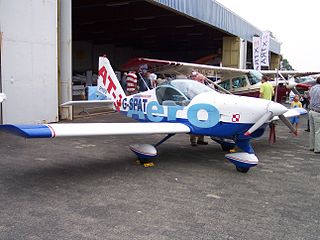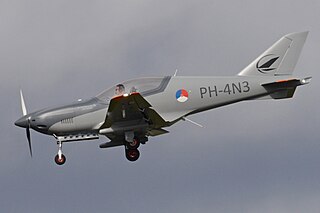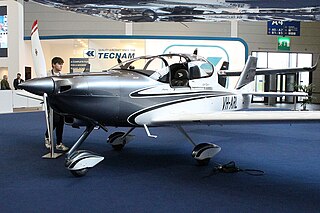
The Aero AT-3 is a two-seat, low wing, utility aircraft manufactured in Poland by Aero AT in ready-to-fly certificated form and as a kitplane. The aircraft is of conventional configuration and features fixed tricycle undercarriage. The structure is largely of all-metal construction. Designed by Tomasz Antoniewski it first flew in 1997 and deliveries to customers commenced in 2002. It is certified under the European Very Light Aircraft regulations. On July 2, 2010 Aero AT-3 was granted an American Federal Aviation Administration type certificate, based on its European VLA certification.

The Flight Design CT series is a family of high-wing, tricycle undercarriage, two seat, ultralight and light-sport aircraft produced by Flight Design of Germany. The family includes the original CT and the CT2K, CTSW, CTLS and the MC models.

The Progressive Aerodyne SeaRey is an American two-seat, single-engine, amphibious flying boat designed and manufactured by Progressive Aerodyne originally in Orlando, Florida, and now in Tavares, Florida. It was first flown in November 1992 and is sold as a kit aircraft for amateur construction as well as a light-sport aircraft.

The Tecnam P92 Echo and Tecnam P92 Eaglet are Italian high-winged, light aircraft, designed by Luigi Pascale and built by Tecnam of Naples.

The AS/SA 202 Bravo is a two to three-seat civil light aircraft jointly designed and manufactured by the Swiss company Flug- und Fahrzeugwerke Altenrhein (FFA) and the Italian company Savoia-Marchetti. The aircraft was designated the AS 202 in Switzerland, and the SA 202 in Italy.

The Fantasy Air Allegro is a Czech two seat, high wing, tricycle gear, single engine monoplane light-sport aircraft or microlight originally designed and built by Fantasy Air and later produced in the United States by Allegro LSA.

The SportStar and EuroStar are a family of a two-seat, light sport aircraft (LSA), manufactured by Evektor-Aerotechnik of the Czech Republic and powered by a Rotax 912ULS, 100 horsepower (75 kW) engine.

The Tecnam P2006T is an Italian high-winged twin-engined all-metal light aircraft, built by Costruzioni Aeronautiche Tecnam based in Capua, Italy, near Naples. The P2006T received airworthiness certification in the European Union by EASA under CS23 in 2003, type certification in 2009, and Federal Aviation Administration FAR Part 23 certification in 2010.

The Tecnam P2008 is a single-engine, high-wing two-seat aircraft built in Italy but aimed at the US market. It is the first Tecnam aircraft to incorporate major composite components. It was introduced at the AERO Friedrichshafen 2009 show, with first deliveries in December 2009.

The Goair Trainer is an Australian single-engined, two-seat, training or touring cabin monoplane designed and built by Goair Products at Bankstown Airport in Sydney, Australia.
The Aviadesign A-16 Sport Falcon is an American light-sport aircraft that was designed by Aviadesign, a certified aircraft modification company based in Camarillo, California. The A-16 was announced at Sun 'n Fun April 2006 and introduced at the LSA Expo held in Sebring, Florida in 2007. The aircraft was to be supplied as a complete ready-to-fly-aircraft.

The Blackshape Prime is an Italian ultralight aircraft, produced by Blackshape srl, the company founded in Monopoli by Luciano Belviso and Angelo Petrosillo. The aircraft first flew in 2007 and was introduced at the Aero show held in Friedrichshafen in 2009. It is supplied as a complete ready-to-fly-aircraft.

The OMA SUD Redbird is an Italian two-seat, composite light-sport aircraft (LSA) from composite maker OMA Sud. Introduced at the AERO Friedrichshafen show in 2012, the aircraft is supplied complete and ready-to-fly.

The Tecnam Astore is an Italian, low wing, two-seater, light-sport aircraft, under development by Tecnam of Naples. It was first flown in early June, 2013, and introduced at the AERO Friedrichshafen show in 2013. It is supplied complete and ready-to-fly.
The Stellar Astra is an American ultralight trike that was designed by Allistair Wilson and produced by Stellar Aircraft of Bloomfield, Indiana. When it was available the aircraft was supplied as a complete ready-to-fly-aircraft. As of 2013 the company appears to be out of business and production complete.
The OneAircraft One is a Slovenian light-sport aircraft (LSA) and certified light aircraft designed by Iztok Šalamon and produced by OneAircraft of Celje. The aircraft is supplied complete and ready-to-fly.
The Rokospol Via is a Czech ultralight and light-sport aircraft (LSA), designed and produced by Rokospol Aviation of Prague, introduced at the Prague airshow in 2008. The aircraft is supplied complete and ready-to-fly.
The Tecnam Snap is an Italian aerobatic ultralight aircraft, designed by Fabio Russo and produced by Tecnam of Casoria, Metropolitan City of Naples, introduced at the AERO Friedrichshafen show in 2013. The aircraft was intended to be supplied complete and ready-to-fly.
The Tecnam P-Mentor is an Italian light aircraft, intended for flight training, designed and produced by Tecnam of Casoria. It was introduced in April 2022 and is EASA CS-23 type certified in Europe.















